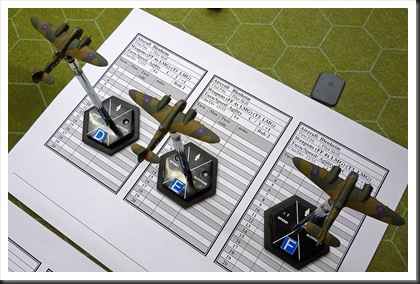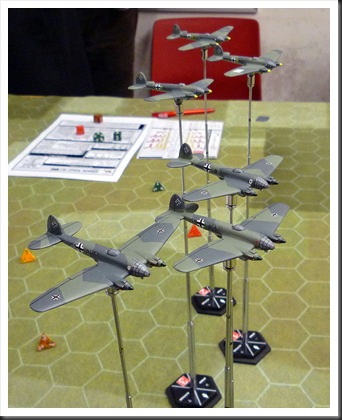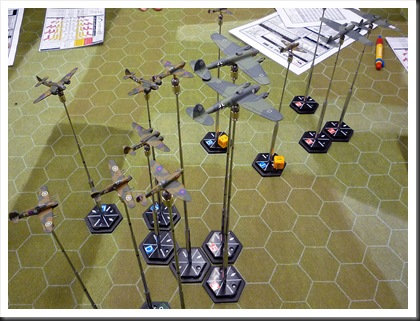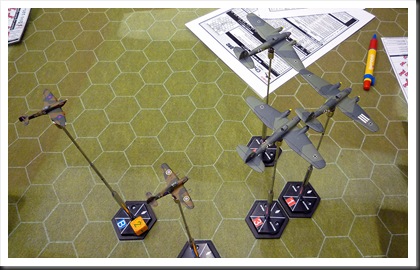Two weeks ago it was time for another ‘Check Your Six’ scenario from ‘Over The Channel’ scenario book. This time it the turn came to ‘Into the darkness’. Name of the scenario refers to the fact that it is a little different from the rest, as it tries to represent the challenge of night bombing raids in those early years of the war.
Setup
To simulate the difference in night and day missions, a couple of special rules are implemented in this scenario. Visibility is very limited, while German bombers are allowed to fly individually. Additionally any airplane that is can be shot at, needs to perform a check for illumination – if it makes it, it is invisible for the rest of the turn.
The game
Goals of this scenario are very simple for both sides. The objective of six Heinkels was simple – try to stay alive while traversing the board. For three sections of British assailants – one section each of Spitfires, Hurricanes and Blenheims – the task was to find the bombers and bring down as many as possible. Their task was made difficult not only by very limited visibility conditions and special rules, but also by random entry points in regard of both location and altitude.
As things turned out, start of the game ment some good news and some bad news for the German players. Blenheims came in low and out of position – this was very fortunate for the opposition, since those obsolete light bombers hastily converted into night fighters are real hogs in regard of speed and climb rate. But any optimism on the German side was quickly dispersed by the fact that both Hurricanes and Spitfires entered the table with height advantage and behind the Heinkels. We didn’t know it by then, but this simple fact more or less decided the outcome of game.
The game itself was straight forward and the events need only few sentences to be described. William and I were in control of the bombers and we decided upon different strategies. My previous experience told me that defensive armament of German bombers can be very effective made me decide to keep my planes in formation. William went for speed and additional maneuverability of bombers flying individually. One of us made the right call, the other was disastrously wrong and payed the price.
I have to add though that I don't think any decisions would change the course of the game – both Hurricanes and Spitfires took full advantage of altitude and speed and came into range within a couple of rounds. Since my three Heinkels were from British point of view was flying slightly behind William’s bombers, they were the natural first target and they took the brunt of British onslaught. As soon as the fighters reached optimal firing position, it was all over but the crying for my doomed Heinkels. A single burst of .303 machine guns was all it took to bring down first victim; other two put up a better fight, but nevertheless went down after being repeatedly by British fighters.
Distraction of three juicy targets or ‘the heroic sacrifice’, as I prefer to call my dismal performance in this game, did have one positive side-effect – it bought William enough time to dive, dive, dive and put some distance between majority of British fighters and his Heinkels.
Nevertheless, one Spitfire and one Hurricane did manage to score some hits into his bombers, with limited success of knocking out both dorsal gun positions on one of the bombers (two lucky hits, both resulting in same effect). This didn’t stop William from exiting the game area with three more or less intact Heinkels.




No comments:
Post a Comment